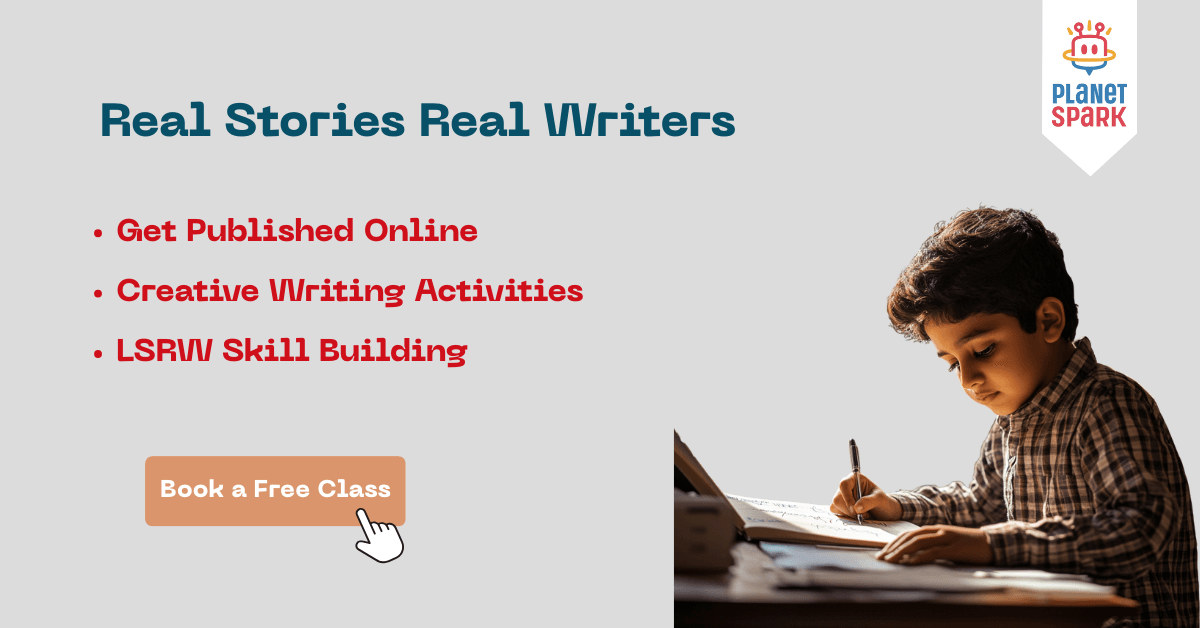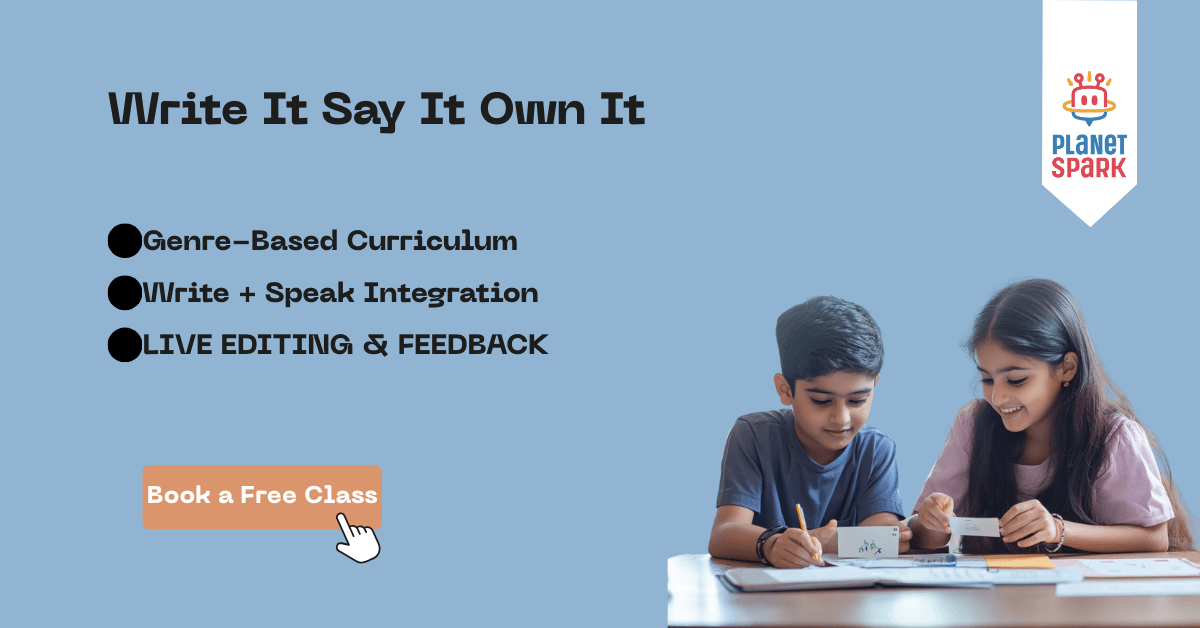Story for Kids: Short English Stories to Inspire Young Minds

Table of Contents
- Why Stories Matter for Kids
- A Short Story for Kids: “Milo and the Lost Moonlight”
- Moral of the Story
- How to Use Stories to Engage Children
- The Role of Storytelling in Early Education
- Digital vs. Traditional Storytelling
- Incorporating Culture and Diversity Through Stories
- Popular Genres of Stories for Kids
- Benefits of Reading an English Story for Kids
- How Parents Can Encourage Story Writing at Home
- Why Kids Should Learn to Write Their Own Stories
- Conclusion:
- FAQs
Stories have always been at the heart of childhood. Whether told by grandparents, read at bedtime, or heard during school sessions, a story for kids can spark imagination, teach values, and even enhance communication skills. Children don't just enjoy stories - they grow through them. From fairy tales to moral stories, and adventures to real-life incidents, stories help shape a child’s understanding of the world around them.
In this blog, we will share the importance of stories in a child's development, provide a delightful short story for kids, and guide you on how to use storytelling as a powerful tool at home or in classrooms.
Why Stories Matter for Kids

Stories serve more than just entertainment - they’re essential learning tools. Here's how:
1. Cognitive Development
Stories help children develop logic, sequencing, and understanding of cause-and-effect relationships. Following a plot helps improve attention span and memory.
2. Moral Learning
Every good English story for kids has a subtle lesson - be kind, brave, honest, or helpful. These are absorbed unconsciously and can help build character.
3. Vocabulary and Language
Listening to or reading a story for kids improves vocabulary, sentence structure, and fluency, especially when told in English. It strengthens communication skills.
4. Emotional Intelligence
Characters in stories go through emotions - joy, fear, sadness, and excitement. When kids relate to them, they develop empathy and learn to express feelings better.
5. Creativity and Imagination
From magical lands to talking animals, stories inspire creative thinking and allow children to dream without limits.
A Short Story for Kids: “Milo and the Lost Moonlight”
Let’s explore a fun and thoughtful short story for kids that teaches the power of kindness and teamwork.
Milo and the Lost Moonlight
Once upon a time, in a small village nestled among snow-capped mountains, lived a curious little fox named Milo. Milo had shiny orange fur, twinkling eyes, and a big dream - he wanted to climb the tallest hill and talk to the moon.
Every night, Milo would look up and whisper, "Hello Moon! Will you ever talk to me?" But the moon never replied. One evening, something strange happened. The sky turned dark earlier than usual. The moon didn’t rise. The stars looked worried.
The animals in the forest panicked. “Where’s the moon?” cried the owls. “How will we find our way at night?” whimpered the raccoons.
Milo, though afraid, decided to find out what had happened. He packed a satchel with cheese, berries, and a flashlight. “I’ll go up the tallest hill and see if the moon is stuck,” he said bravely.
Along the way, he met different animals. A sleepy bear who helped move a fallen log, a squirrel who pointed him in the right direction, and a deer who gave him water. Everyone helped Milo on his journey.
Finally, Milo reached the top and gasped! The moon was hiding behind a dark cloud. “Why are you hiding?” Milo asked gently.
“I’m sad,” whispered the moon. “No one ever says thank you for the light I give. I thought maybe I should just disappear.”
Milo sat quietly, then said, “But you’re so special! We all love you. We just didn’t know how to say it.” He took out a piece of his berry cake and offered it to the moon. “This is for you.”
The moon giggled and peeked out. Her light returned to the sky. The forest cheered as the moonlight bathed them in silver again.
From that night on, all the animals howled, chirped, and clapped when the moon rose, and Milo became the hero of the hills.
Moral of the Story
Appreciation matters. Even the ones who shine the brightest need to be acknowledged and loved.
How to Use Stories to Engage Children
If you're a parent or teacher looking to build communication, reading, or creative writing skills, storytelling is the best way to do it. Here are some tips:
1. Create a Story Time Ritual
Choose a fixed time every evening or week for reading or telling an English story for kids. It builds routine and excitement.
2. Use Voice and Expression
Dramatize voices for different characters. It keeps kids engaged and helps them learn emotions and tone.
3. Ask Questions After the Story
“What would you do if you were Milo?” or “What did the moon feel?” These help children think critically.
4. Turn Stories into Writing Projects
Encourage children to create their own story for kids based on what they read or heard. It enhances writing and imagination.
The Role of Storytelling in Early Education
In early childhood education, stories play an important role in preparing children for structured learning environments like schools. Educational psychologists emphasize that when stories are used as teaching tools, they promote cognitive flexibility, making it easier for young minds to absorb new ideas, vocabulary, and ways of thinking.
Teachers often use storytelling to introduce subjects like science, history, and even math. For example, a short story for kids about a boy who counts stars in the sky can subtly teach numbers and patterns. Similarly, a tale about a thirsty crow teaches problem-solving and introduces basic physics in a relatable context.
When stories are told with voice modulation and gestures, they activate multiple parts of the brain, making the learning experience multisensory. Children retain lessons much better when they are emotionally connected to a character or a situation in the story.
Digital vs. Traditional Storytelling
In the digital age, stories come in many formats - print books, audiobooks, animated videos, and even interactive apps. While traditional printed books still hold immense value, digital storytelling has expanded access and engagement for children worldwide.
Audiobooks are perfect for bedtime listening or car rides.
Animated stories with subtitles help visual learners.
Interactive apps allow children to choose endings, improving decision-making and creativity.
However, parents need to strike a balance. While technology offers convenience and variety, nothing replaces the warmth of a bedtime story read aloud by a parent or guardian. Children often treasure those quiet storytelling moments as some of their fondest memories.
Incorporating Culture and Diversity Through Stories
Another benefit of reading an English story for kids is the opportunity to expose children to global cultures, traditions, and values. Stories from different parts of the world help children understand and respect diversity.
For instance:
A Japanese folktale teaches honor and perseverance.
An African jungle story introduces wildlife conservation.
An Indian fable from the Panchatantra imparts moral values.
These stories not only entertain but also build global citizens - children who are empathetic, informed, and open-minded.

Popular Genres of Stories for Kids
1. Moral Stories
Teach values like honesty, responsibility, and kindness.
2. Adventure Stories
Excite children and stimulate problem-solving skills.
3. Fables and Folktales
Use animals or imaginary characters to convey powerful messages.
4. Fantasy Stories
Create magical realms with unicorns, fairies, or dragons that expand creative thinking.
5. Real-Life Inspired Stories
Let kids relate to everyday heroes or events. These stories help children see the extraordinary in the ordinary.
Benefits of Reading an English Story for Kids
Helps non-native speakers become fluent in English
Develops comprehension and expression
Boosts confidence in speaking and writing
Prepares kids for school essays and assignments
How Parents Can Encourage Story Writing at Home
One of the best ways to support young writers is by offering them structured writing practice. For instance, this guided paragraph writing worksheet for Class 3 by PlanetSpark is a great place to start. It helps children organize their thoughts, improve coherence, and practice age-appropriate written expression in a fun way.
Keep a story journal
Provide prompts: “Write about a magical pencil!”
Use pictures to inspire a story
Reward effort with praise, not perfection
Share their stories with family to boost confidence
Give your child the opportunity to write beautifully structured and meaningful stories through PlanetSpark’s expert-designed creative writing curriculum.

Why Kids Should Learn to Write Their Own Stories
Writing isn’t just about grammar - it’s about expressing thoughts, understanding emotions, and connecting with readers. Children who write regularly:
Think deeply
Develop empathy
Improve language fluency
Perform better academically
Whether it's a short story for kids or a paragraph about a dream, every word counts.
Conclusion:
From Milo’s moonlight adventure to your child’s next bedtime tale, every story for kids is a tool for growth. Reading and writing stories not only entertain but also educate, empower, and elevate a child’s emotional and intellectual potential.
The next time you read an English story for kids, think of it as more than just a tale - it’s a window into imagination, a lesson in values, and a seed of creativity waiting to bloom.
FAQs
1. Why are stories important for children?
Ans. Stories help kids build language skills, understand values, express emotions, and boost creativity.
2. Can short stories really improve a child’s writing skills?
Ans. Yes! Reading a short story for kids regularly exposes them to vocabulary, structure, and ideas, which improves their writing fluency.
3. At what age should children start reading or listening to stories?
Ans. Storytelling can start as early as infancy. Picture books and spoken tales are great for toddlers, while kids aged 5+ can enjoy short or structured stories.
4. How does storytelling enhance learning?
Ans. Storytelling improves memory, builds empathy, encourages focus, and makes learning fun by embedding concepts into engaging narratives.
5. What is the best way to encourage kids to write their own stories?
Ans. Enroll them in a creative writing course like PlanetSpark’s, offer prompts, provide positive feedback, and make writing a fun, regular activity.

Hi There, want to try these
tips for your child with
LIVE with our expert coach?
Let's check your child's
English fluency
